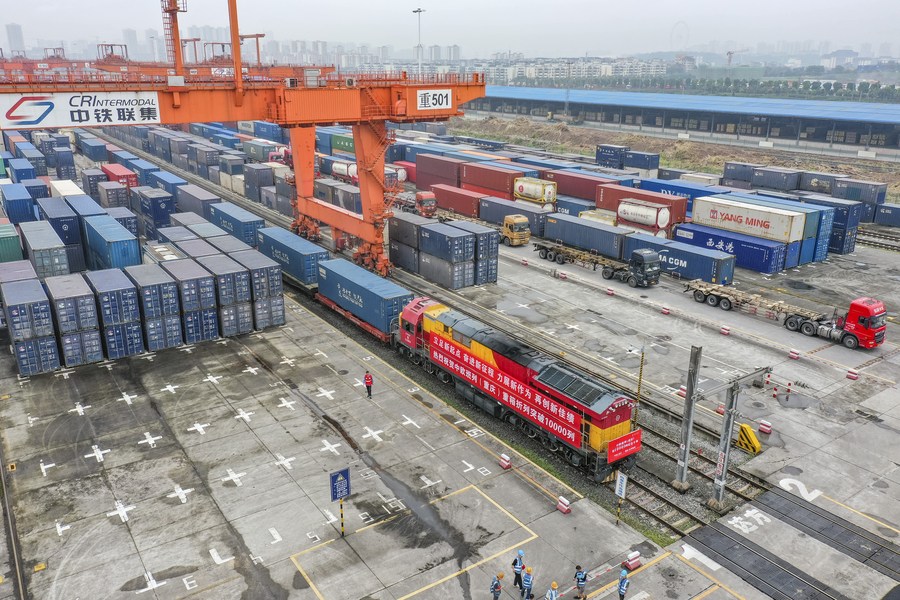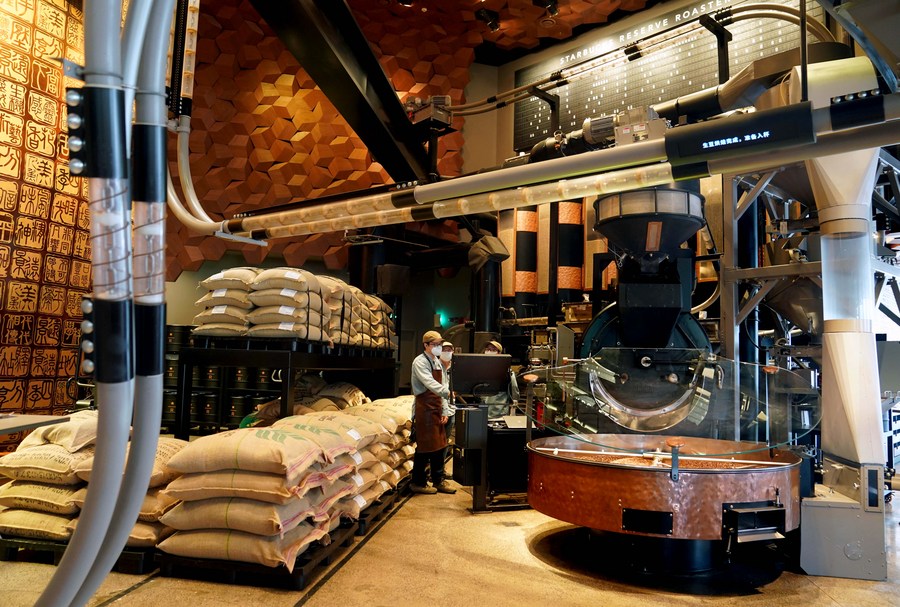
China's foreign trade saw double-digit growth in the first seven months of 2022 amid policy support and a boost from Regional Comprehensive Economic Partnership (RCEP) agreements.
During the January-July period, the country's foreign trade of goods jumped 10.4 percent year on year to 23.6 trillion yuan (about 3.5 trillion U.S. dollars), official data showed Sunday.
Exports rose 14.7 percent year on year to 13.37 trillion yuan, while imports increased 5.3 percent from a year ago to 10.23 trillion yuan, according to the General Administration of Customs (GAC).
In July alone, foreign trade jumped 16.6 percent from a year ago, with the Yangtze River Delta region seeing rapid growth of 25.7 percent, according to GAC spokesperson Li Kuiwen.

Aerial photo taken on June 23, 2022 shows a cargo train, which marks the 10,000th trip made by China-Europe freight trains operated by the China-Europe Railway Express (Chongqing), waiting for departure at Tuanjie Village Central Railway Station in Chongqing, southwest China. (Xinhua/Huang Wei)
SWIFT AND STEADY
During the period, China's trade with the Association of Southeast Asian Nations, the European Union and the United States expanded 13.2 percent, 8.9 percent and 11.8 percent from a year ago, respectively.
From January to July, China's trade with Belt and Road countries soared 19.8 percent year on year, and its trade with other RCEP members rose 7.5 percent.
Private enterprises posted strong performances, with their imports and exports growing 15.3 percent year on year in the seven months, accounting for 50 percent of the country's overall trade volume.
Exports of mechanical and electrical products expanded 10.1 percent to account for 56.6 percent of the total, while exports of labor-intensive products increased 15.2 percent, the data showed.

Aerial photo taken on June 9, 2022 shows a container terminal in Qingdao Port, east China's Shandong Province. (Photo by Yu Fangping/Xinhua)
RCEP A KEY BOOSTER
In July, trade with RCEP partners reached 1.17 trillion yuan, soaring 18.8 percent year on year and boosting China's overall foreign trade growth by 5.6 percentage points, Li said.
The RCEP agreement -- the world's largest free trade deal between 10 ASEAN member states plus China, Japan, the Republic of Korea, Australia and New Zealand -- came into force on the first day of 2022, and Chinese foreign trade enterprises have since benefited from various trading dividends.
The RCEP framework has further deepened regional economic connectivity as well as trade and investment cooperation, and it has provided new drivers for regional economic recovery and development, Li said.
The countries under the framework account for roughly 30 percent of the world's gross domestic product and population. Over 90 percent of trade in goods among approved member states will gradually become tariff-free.

A worker arranges durians at a durian processing factory in the Chanthaburi province, Thailand, May 5, 2022. This year, after the Regional Comprehensive Economic Partnership (RCEP) entered into force in January, Thailand's durian sales to China have been further boosted. (Xinhua/Wang Teng)
RESILIENT AND ATTRACTIVE
With a slew of measures to stabilize foreign trade and investment having paid off, China's foreign trade of goods and the amount of foreign capital actually used both posted marked growth in the first half of the year.
The foreign trade growth continued the upward trend that began in May, making positive contributions to stabilizing the macroeconomic market, Li said.
China's gross domestic product expanded 2.5 percent year on year in the first half of 2022, data from the National Bureau of Statistics showed.
Foreign direct investment (FDI) into the Chinese mainland, in actual use, expanded 17.4 percent year on year to 723.31 billion yuan in the first half of the year.

Staff members work at the Starbucks Reserve Roastery in Shanghai, east China, June 3, 2022. (Xinhua/Liu Ying)
The country's high-tech industries saw a rapid FDI increase of 33.6 percent in the first half of 2022. Foreign investment in high-tech manufacturing rose 31.1 percent, and that in the high-tech services sector jumped 34.4 percent.
According to a June report from the European Chamber of Commerce in China in partnership with the Mercator Institute for China Studies, many European companies are optimistic about China's huge market potential and the rapid commercial application of China's R&D achievements, and will increase their R&D spending in China this year.
Next, China will further boost exports, expand imports and promote the introduction of technology and foreign investment, according to a meeting of the Political Bureau of the Communist Party of China Central Committee that analyzed the current economic situation and arranged economic work for the second half of the year.
Efforts should be made to enhance the stability and international competitiveness of industrial and supply chains, and high-quality Belt and Road cooperation should also be promoted, the meeting said.